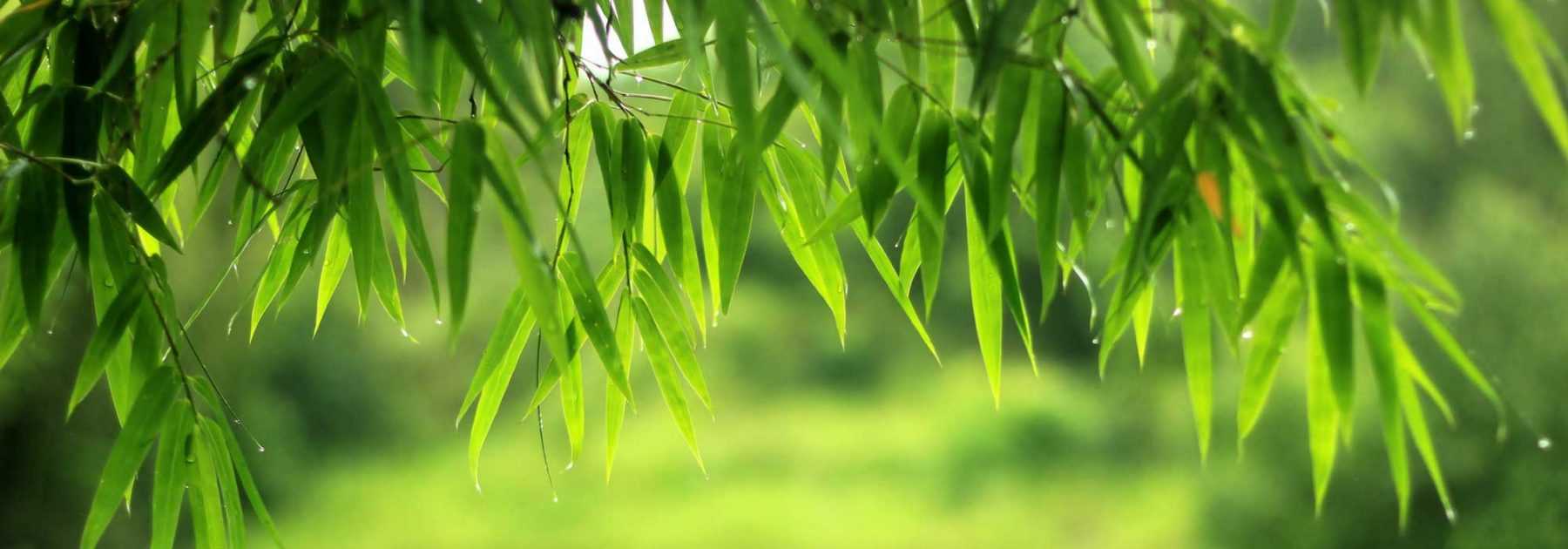
Bamboos: Planting, Pruning, and Care
Contents
Bamboo in a Nutshell
- Bamboos bring “the” exotic touch to the garden
- They are evergreen but sometimes invasive
- Their growth is very rapid
- Easy to maintain, they are hardy and resilient
- They can be used for hedges, beds, as standalone plants or in pots
Our expert's word
With their graphic and evergreen foliage, rustling at the slightest breeze, and their sturdy, upright coloured canes or culms, bamboos structure the garden even in winter, bringing an exceedingly exotic, zen or contemporary touch all year round.
From potted bamboo to giant bamboo, including dwarf bamboo, the term “bamboo” evokes an Asian restaurant in Paris for food lovers, but it actually encompasses a vast diversity of genera, more or less invasive species, and plant varieties. Forget the florist’s “Lucky Bamboo” or “Dracaena sanderiana” and the Sacred Bamboo (Nandina domestica): despite their common names, they have nothing to do with the true bamboo genus!
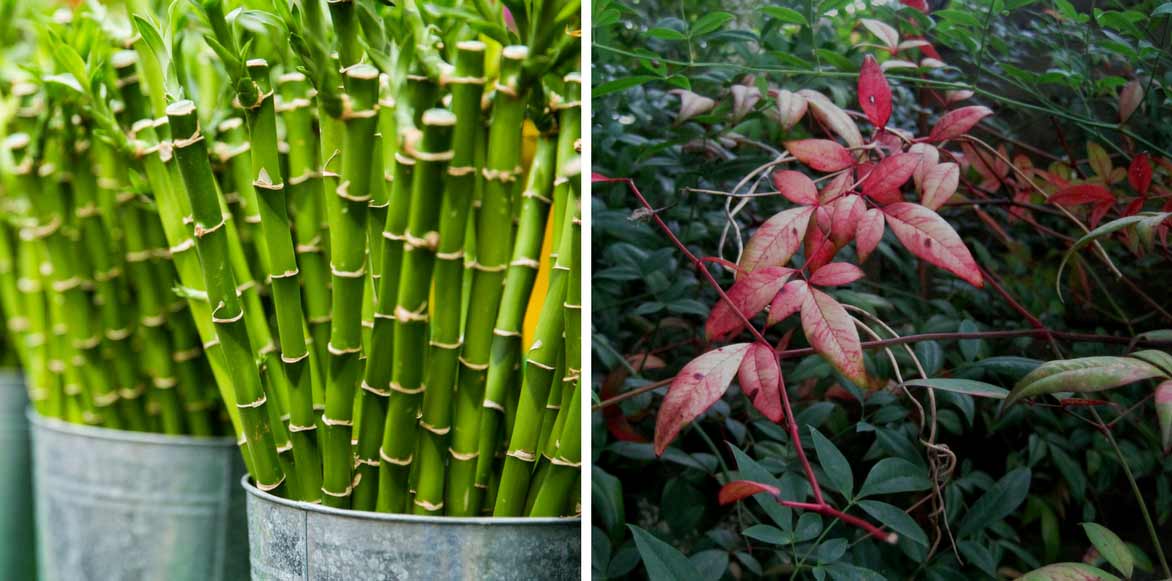
Whether they are running bamboos like Phyllostachys, moderately spreading, or clumping bamboos (non-invasive) like Fargesia, all create highly exotic scenes.
In the garden, they establish quickly, with rapid growth, soon forming beautiful privacy or windbreak hedges, noise-reducing green screens, enchanting forests, light yet structured beds, or lush ground covers. Dwarf bamboos also work wonders as low hedges, ground covers, or potted plants on a terrace or balcony. As a bonus, dried bamboo canes make excellent supports for clematis or dahlias.
They thrive in non-scorching sun as well as shade, in any soil that remains moist.
Don’t be fooled by their tropical appearance: while some species are frost-sensitive (-10°C), most bamboos can withstand temperatures as low as -25°C and adapt to all regions.
Fancy buying bamboo online? Explore our range of bamboos in all sizes and choose from our exceptional collection the one that will bring the spirit of the Land of the Rising Sun to your garden or terrace!
Botany
Botanical data
- Latin name Phyllostachys, Sasa, Arundinaria, Fargesia, Chusquea...
- Family Poaceae
- Common name Bamboo
- Height 0.70 to 10 m and more
- Exposure Sun, partial shade
- Soil type Neutral, acidic
- Hardiness -10°C to -25°C depending on variety
Bamboos are woody grasses from the Poaceae family, originating from temperate and subtropical forests in Asia (from China and Japan where they are highly appreciated by pandas), Africa, and Central and South America where they can be found up to 3000 metres in altitude. Bamboos have widely acclimatised to our European gardens. The term ‘bamboo’ encompasses a large number of genera, species, and varieties.
There are 80 genera and over 1000 species of bamboo. Their height varies depending on the species. Bamboos are classified into three size categories, from dwarf bamboo like the Pleioblastus viridistriatus to giants like Phyllostachys vivax: dwarfs measure from 20 cm to 1.50 m in height, small and medium varieties from 1.50 m to 10 m, and giants from 10 m and more.
They are also categorised by their growth type: running species like Phyllostachys, which multiply rapidly via their rhizomes to the point of becoming invasive quickly, and whose spread can be contained by a rhizome barrier, and non-running or “clumping” bamboos like Fargesia which grow in compact clumps and, unlike other bamboos, are non-invasive. The root system of bamboos is very dense but shallow.
Non-running bamboos (Fargesia) with clumping rhizomes develop slowly around and at the centre of the clump, they thicken slowly, become bushier but do not spread. There are also lesser-known, less invasive species like semiarundinaria fastuosa with an extraordinarily vertical, columnar habit.
Running bamboos quickly form an intricate underground network of rhizomes that grow in lines, giving rise to new culms. These rhizomes can grow several metres in a year. This earns bamboo its reputation as a born coloniser. Highly invasive bamboos are capable of covering an area of 20 square metres in just 10 years. Under optimal growing conditions, some bamboos can grow several centimetres per day, up to 1 m!
Ground-covering and medium-sized varieties grow relatively quickly and reach their mature size in a few years. Giant varieties reaching over 10 m in height will only achieve full development in 7 to 10 years.
Bamboos display a dense, upright, bushy habit, more or less erect with sometimes drooping tips. Clumping bamboos form a compact, tight clump that flares upwards. Shoots or young growths develop on the rhizomes, giving rise to slender yet robust canes called culms. Some species have edible young shoots once boiled.
These culms or canes, slender or as wide as posts, range from less than a few centimetres to over 25 m tall depending on the species. With variable diameters (from a few millimetres to nearly 20 cm in diameter), each culm consists of stacked hollow tubes partitioned at intervals by nodes. These internodes, more or less swollen depending on the species, give the cane its flexibility. The inner tissue is much less hard than the stem. While the canes are perfectly straight in most species, some bamboos produce twisted culms at the base, like Phyllostachys zig-zag.
The smooth or grooved culms divide into slender branches bearing leaves. Young culms are sometimes covered with a white bloom that quickly disappears. They exhibit varied appearances.
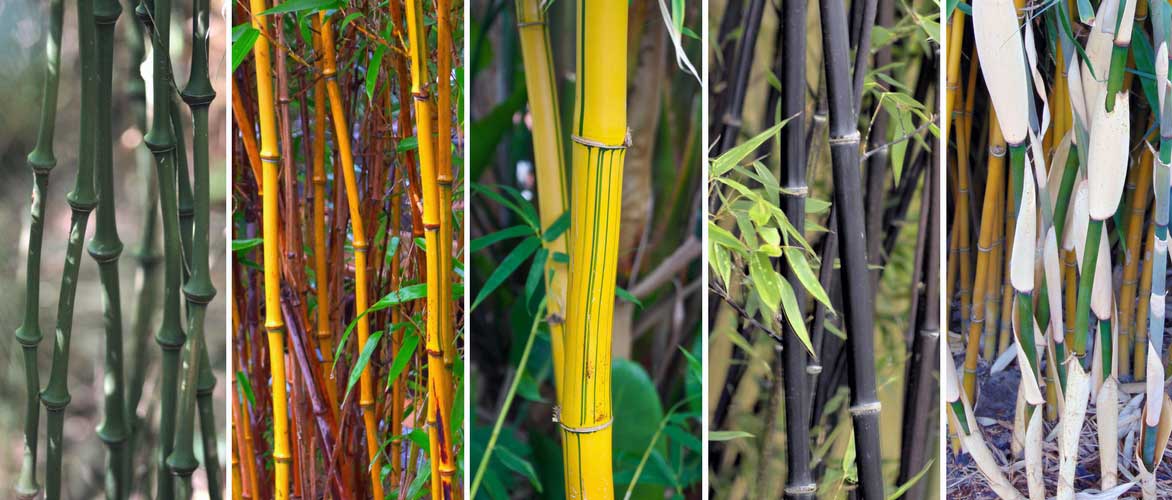
The great diversity of bamboos is also expressed through their highly graphic canes. Chimonobambusa tumidissinoda / Phyllostachys aureosulcata spectabilis / Phyllostachys vivax aureocaulis / Phyllostachys nigra / Fargesia robusta Wolong
Their colours range from intense medium green, to lime green, olive green, pink-yellow, bright yellow, or almost golden, to black, mahogany, or even steely blue. Often, the culms gradually change hue over time and with sunlight, shifting from green to sulphur yellow, grey, pink, or red. Thus, canes of different ages, displaying varied shades, coexist in beautiful harmony.
Some culms take on a striped or bicoloured appearance and are adorned along their entire length with subtle streaks, sometimes with a contrasting coloured ring observed under each node.
They are sometimes embellished with persistent culm sheaths that remain attached to the canes for a few months before falling, offering lovely contrasting effects between the sheath colour, the culms, and the foliage.
These canes are resistant to strong winds, possess a certain flexibility, and rarely break except in Phyllostachys vivax, whose thin walls are fragile . This beautiful flexibility makes bamboos useful, once dried, as stakes, structural bases for light constructions, furniture making, flooring, musical instruments…
The main appeal of bamboos lies in their ample foliage with an unusual graphic quality, rustling at the slightest breeze.
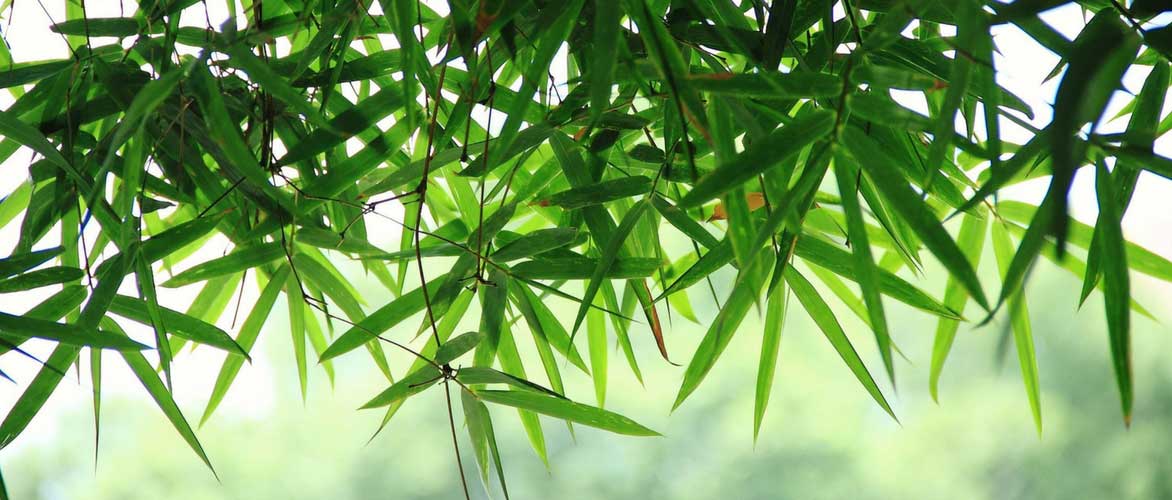
This evergreen foliage is distributed along almost the entire height of the culms. It is often densely branched towards the top. The branches, themselves divided into smaller branches, emerge from the nodes. Bamboos always retain a bushy yet light silhouette. The leaves, measuring from 2 to 25 cm long, more or less narrow and lanceolate, tapering at the tip, are grouped in dense clusters along secondary stems. Their colour varies by species and variety, from dark green, striped, or edged with beige or yellow at the first frosts. They sometimes take on an orange hue with age. The leaves dry, fall, but are quickly renewed.
Bamboo flowering is of little interest. It is rare, irregular, and unpredictable. It is a bad sign and often heralds the death of the plant: the culms dry out and die after flowering.
Hardy, perfectly cold-resistant (down to -25°C depending on the species), and truly undemanding regarding exposure, they prefer partial shade but tolerate sun well as long as they don’t lack moisture.
While bamboos thrive in any good garden soil, the quality and moisture level of the soil nevertheless condition their healthy development. They all appreciate summer moisture, warmth, and fertile soils and grow quickly if these conditions are met. They will rapidly colonise any moist soil, whether acidic or neutral, as long as it is rich, light, fresh, without excess lime. They will establish more slowly in poor soil.
Though they are the undisputed stars of Asian-inspired gardens, bamboos adapt to many styles, from the most contemporary to the most exotic, from the most zen to the most wild.
Perfect as standalone clumps, bamboos also form majestic windbreaks or privacy screens, small hedges, or ground covers. Planted en masse, they quickly create forests of elegant exoticism.
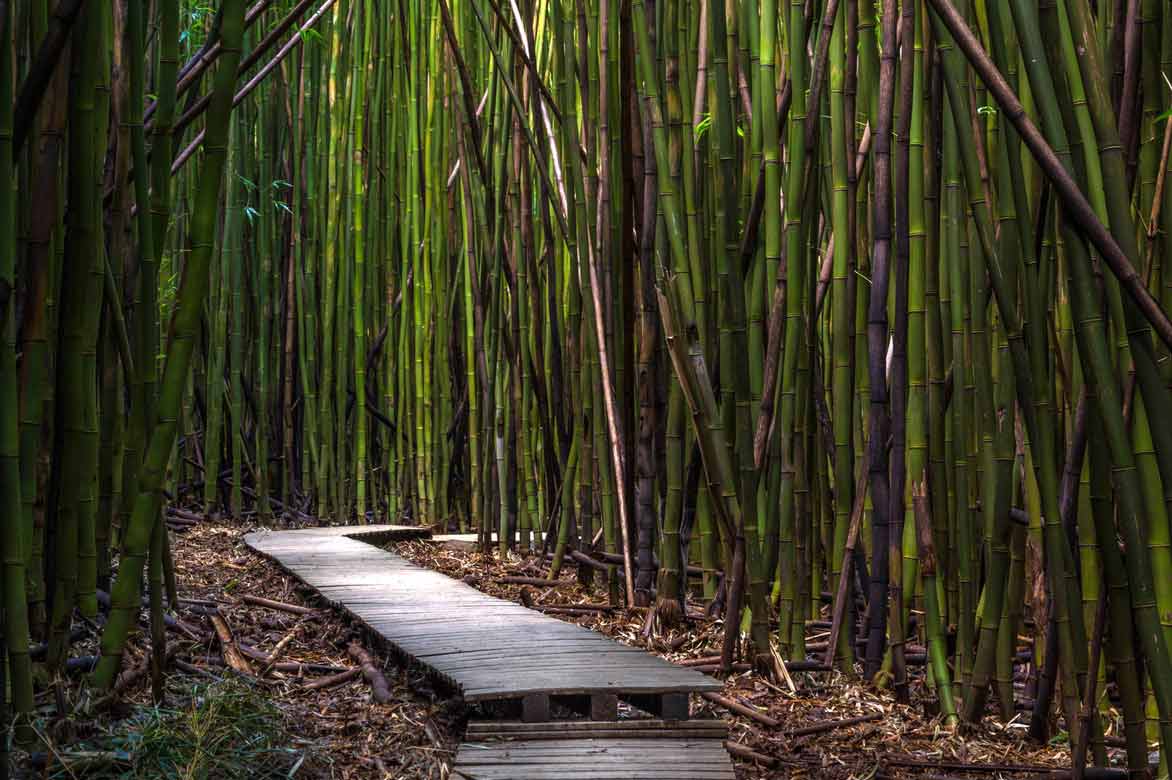
Running bamboos, imposing in stature, lend the garden a highly architectural dimension. Non-running species (clumping bamboos) are easily planted in small gardens or in large pots on balconies or terraces.
Bamboo is indestructible, having survived the Hiroshima bomb.
Read also
How to divide and multiply your bamboos?Species and main varieties
There isn’t just one bamboo, but many. Bamboos offer an immense diversity of genera, species, and varieties. Between the architectural running bamboos, like the Phyllostachys, renowned for their rapid growth, and the non-running bamboos, known as “clumping” with their non-invasive nature, making a choice isn’t easy!
In the family of running bamboos, alongside the Phyllostachys, the most well-known of the genus, we find the Semiarundinaria, Pleioblastus, Sasa, Chimonobambusa, and Shibatea.
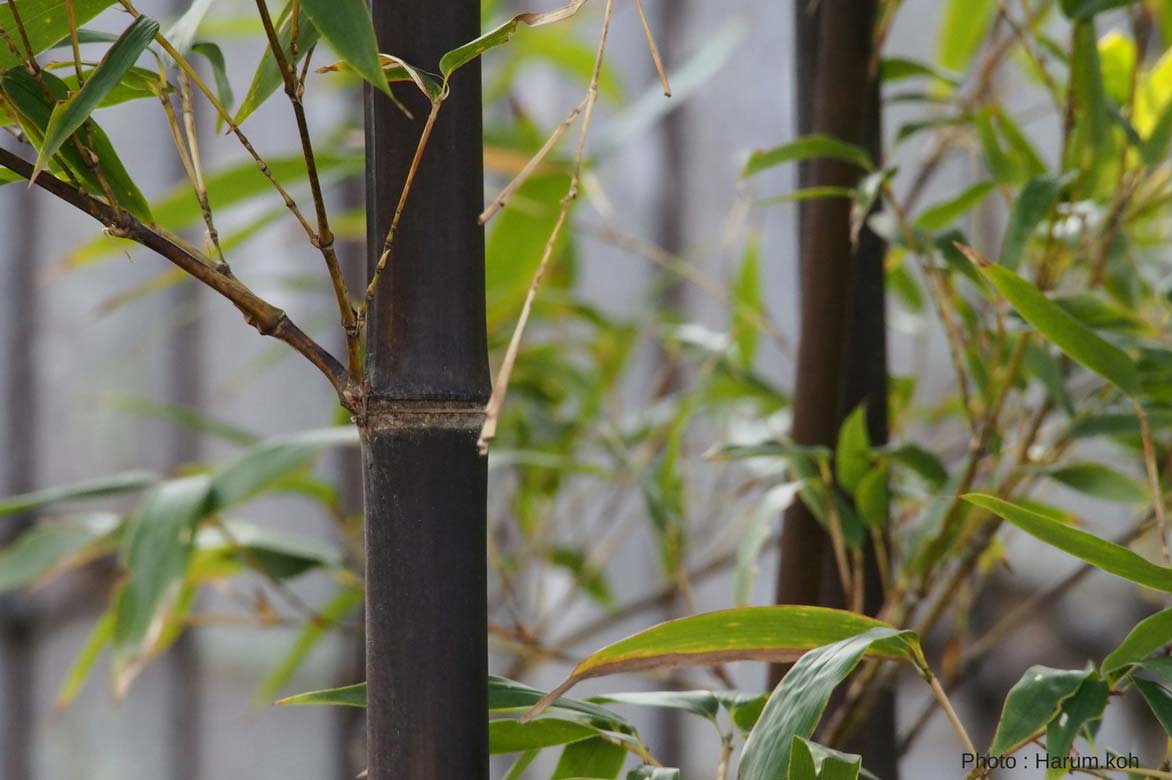
Phyllostachys nigra or Black Bamboo: a highly prized variety in gardens
Among the clumping (non-running) bamboos, the famous Fargesia is well-known, but there are also the Yushania, Chusquea, Thamnocalamus, and Indocalamus—lesser-known but just as interesting.
Running bamboos have only one drawback: in favourable soil, they spread at lightning speed and require the installation of a rhizome barrier.
Check out our guide to learn how to install a rhizome barrier.
Requiring little to no maintenance, most bamboos are highly hardy and boast strikingly colourful, graphic canes (like the stunning dark culms of Phyllostachys nigra or Black Bamboo, or the bright yellow of Phyllostachys aureosulcata ‘Aureocaulis’) and beautiful evergreen foliage, sometimes variegated with gold or beige.
We offer a wide selection of bamboos in all sizes, suitable for every garden—even container growing. Discover our most beautiful varieties, from the classics to the most unusual!

Golden Bamboo - Phyllostachys aurea
- Height at maturity 6 m

Black bamboo - Phyllostachys nigra
- Height at maturity 6 m
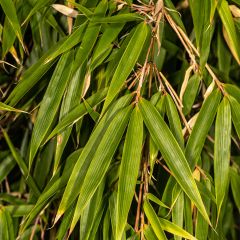
Fargesia robusta - Non-running Bamboo
- Height at maturity 4 m
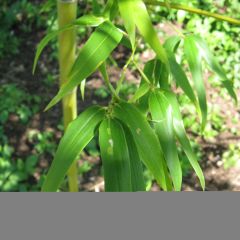
Semiarundinaria fastuosa - Medium-sized Bamboo
- Height at maturity 7 m

Fargesia robusta Pingwu - Non-running bamboo
- Height at maturity 4,50 m

Fargesia robusta Wolong
- Height at maturity 5 m
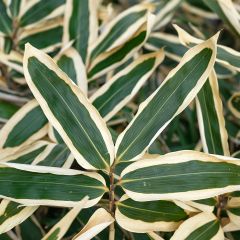
Sasa veitchii
- Height at maturity 1,20 m
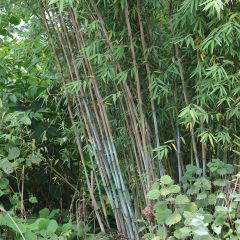
Fargesia papyrifera Blue Dragon - Non-running bamboo
- Height at maturity 6 m

Fargesia scabrida Asian Wonder - Non-running Bamboo
- Height at maturity 3,50 m
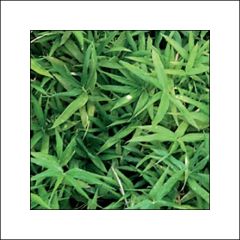
Pleioblastus viridistriatus Vagans - Dwarf Bamboo
- Height at maturity 70 cm
Discover other Spreading Bamboo
Planting
Where to plant bamboo?
Perfectly hardy, bamboos withstand cold well, some down to -20°C or even lower. They thrive throughout France. Shelter them from cold, dry winds to which they are quite sensitive.
They appreciate partial shade but tolerate sun well. Bamboos prefer neutral or acidic soil without excess lime, rather rich, moist and well-drained. They like slightly damp soil in summer, but hate having their feet in water during winter: waterlogged soil would lead to fatal rotting.
Before planting, keep in mind that running bamboos can quickly become invasive. Think carefully about their placement and the space you wish to give them. You can limit the spread of their running rhizomes by defining their space at planting with a polypropylene rhizome barrier planted vertically in the ground around the plant. For more information, see our detailed step-by-step guide:
Running bamboos, such as Phyllostachys, are imposing, reaching heights of nearly 10 metres. Give them space to grow!
Fortunately, for small spaces or large pots, there are clumping (non-running) bamboos that are just as ornamental and do not require containment by a rhizome barrier. Dwarf bamboos generally do not exceed 1.5m and also grow perfectly well in pots. In the garden, they work wonderfully as low hedges or ground cover.
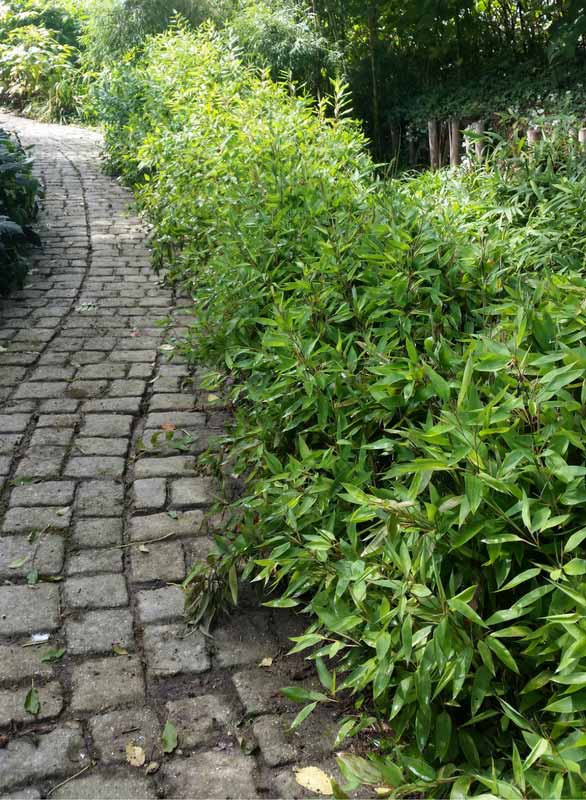
Shibataea kumasaca is a dwarf bamboo, perfect for edging a path
Depending on their mature height, they can form dense, decorative hedges, privacy screens or windbreaks, or evergreen backdrops for borders, whether in the ground or in large containers on balconies or terraces. They can also be grown as standalone clumps.
When to plant bamboo?
The best time to plant bamboo is ideally in late summer and autumn, from late August to October. You can also plant between March and April in regions north of the Loire or between September and November in southern regions. In all cases, plant bamboo in spring after the last frosts or in autumn after the hottest weather.
How to plant
Planting in the ground or in pots is a crucial step, as it determines the establishment and healthy growth of your bamboos, which must never lack water. Bamboos will grow more or less quickly depending on growing conditions.
- In the ground
In a wide, deep hole, install a rhizome barrier to control the spread of running varieties. It should protrude 5cm above ground. Place the rootball in the centre of the hole. Backfill with garden soil mixed with good planting compost and manure. Bamboos need plenty of water to establish – water generously at planting and very regularly in the first year, especially in summer when the soil is very dry. Later, their fallen dry leaves will form a natural mulch at the base, but in the first few years, don’t hesitate to add a mulch of wood chips or pine bark.
- In pots:
Bamboos tolerate container growing well, provided watering is carefully monitored. Choose your species wisely (some overly vigorous types could quickly burst the pot) and opt for non-running or compact bamboos. Plant them in a sufficiently large pot, at least 50cm deep, in a rich, well-draining mix (planting compost or rose soil mixed with garden loam). Give them a spot in non-scorching sun and sheltered from draughts. Potted bamboos must never dry out – monitor watering closely, which should be very regular, especially during prolonged dry spells.
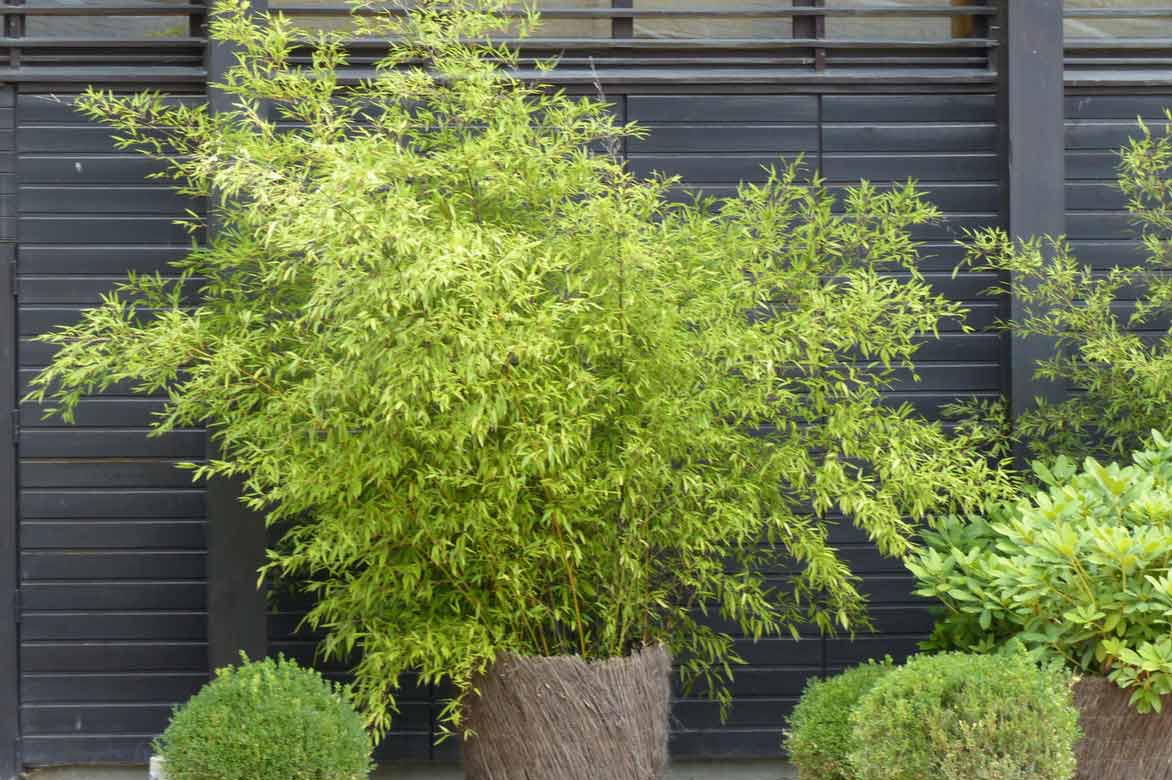
Phyllostachys aurea in a pot
Care, Pruning and Maintenance
Once well established, bamboos require almost no maintenance but they are thirsty plants. In summer and during dry spells, water generously at the base and mist the foliage in the evening. To establish roots and grow well, young plants need regular watering during the first two years after planting.
Potted specimens also require more frequent watering; make sure the soil doesn’t dry out too much between waterings, as they can drink up to 5 litres per day during hot weather. In the first few years, mulching will help keep the soil moist in summer. However, over time, you’ll notice that bamboos mulch themselves naturally with their dry leaves, which decompose very slowly.
→ Learn more in our guide How to properly water a potted bamboo?
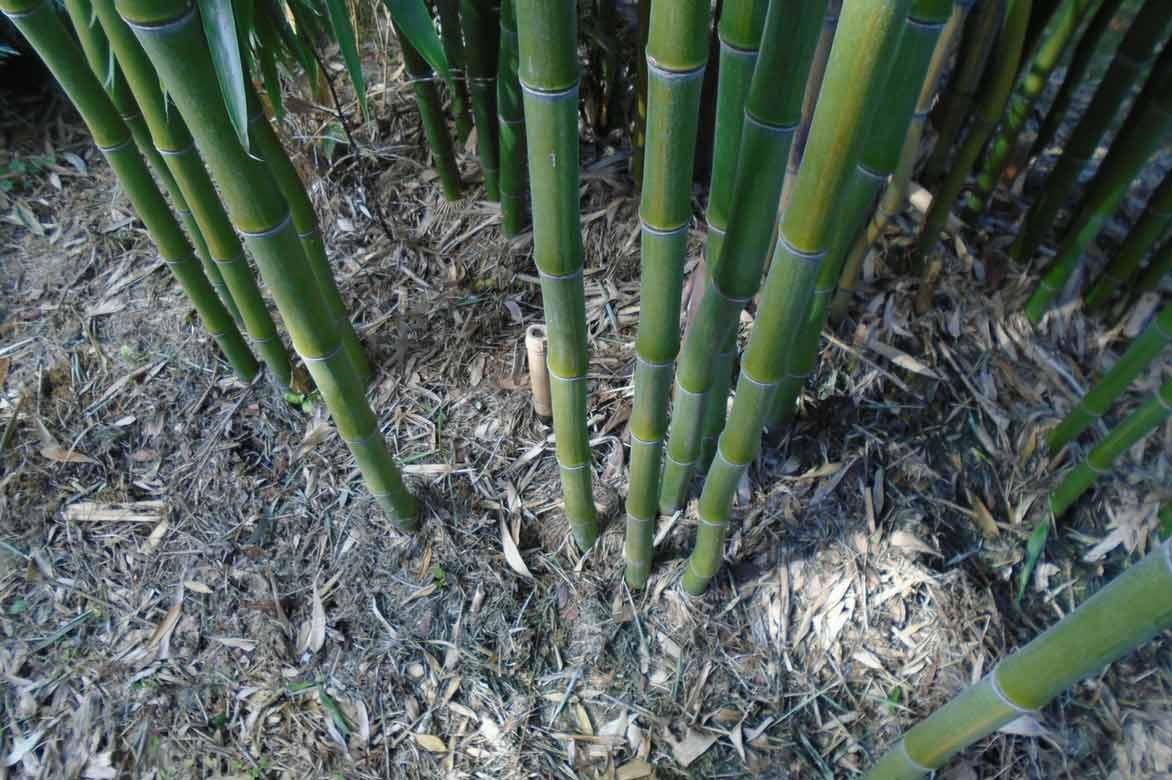
Leave bamboo leaves at their base: they “self-mulch” naturally!
Bamboos thrive in fertile soil: in early spring, you can add rich compost or a nitrogen-rich bamboo fertiliser, twice a year for bamboos grown in containers. If the leaves tend to yellow, this may indicate excess lime in the soil: add ericaceous compost on the surface.
Pruning bamboos is not necessary. However, they tolerate being trimmed with shears in late summer around August-September, either to shape them as desired, control their growth, or remove dry canes (once fully dried, they can be used as plant supports). Every year, cut dry, weak or obstructive culms back to the base. This maintenance pruning will encourage the plant to produce entirely new, denser foliage. However, note that once cut, the canes will not regrow.
In winter, don’t hesitate to clear snow from the culms: even though the canes are remarkably flexible, they may break under the weight.
Diseases and potential pests
Bamboos are not fragile and are resistant to most diseases and pests. However, they can become more vulnerable when weakened by excess water and lack of nutrients.
When the weather is hot and humid, potted bamboos are sometimes prone to attacks by mealybugs, which feed on the sap and leave white, powdery or cottony clusters on the plant. The leaves eventually turn yellow and fall off, potentially leading to the plant’s demise in the worst cases. Spraying a mixture of vegetable oil (rapeseed or olive oil), 90° alcohol and black soap can suffocate them. In case of severe infestation, cut off and burn the affected parts. Red spider mites can also cause yellowing and drying of the leaves, which eventually drop. Treat with an acaricide.
→ Learn more in our guide Bamboo diseases and pests
Propagation
Bamboos spread rapidly, making it easy to take advantage of this natural tendency to acquire new plants at a lower cost. Propagation is done in spring, during March-April by dividing clumps, and should be performed on clumps that are at least three years old. Carry out the process when the soil is sufficiently moist to make extracting the divisions easier. Propagation by rhizome cuttings is also possible with some running species, but the success rate is too unpredictable to be recommended.
Dividing clumps:
- Using a sharp spade, take a good-sized clump from the outer edge of the main root ball, ensuring it has at least 2 culms (ideally 3 to 5).
- Shorten existing culms by one-third of their length, always keeping some foliage (divisions without leaves won’t regrow).
- Plant the clump in a hole enriched with nutrient-rich compost.
- Backfill, firm the soil, and mulch.
- Stake the plant at three points to secure it firmly (tall bamboos have significant wind resistance).
- Water thoroughly, then keep the soil moist but not waterlogged.
- Regularly mist the foliage in dry or windy weather, either in the evening or morning, to prevent leaf desiccation and ensure successful establishment.
Once divided, large bamboos regrow from a juvenile stage. New culms that emerge will be smaller in height and girth. It will take several more years before they reach the size of the parent plant.
Pairing
With their elegant foliage, sometimes variegated with green, cream or yellow, and their graphic silhouette, bamboos, though often self-sufficient, lend themselves to multiple uses. They always bring luminosity, movement and verticality to a setting.
They help maintain a beautiful garden even in winter, as frost enhances their elegant silhouette and evergreen foliage.
Undisputed stars of Asian-inspired gardens, bamboos blend seamlessly into all garden styles, whether contemporary, Zen, exotic, wild or natural. Some, like Phyllostachys atrovaginata ‘Green Perfume’, particularly suited to damp areas, even add verticality to water gardens, alongside astilbes, sedges, rushes, goat’s beard or giant gunneras.
Used as standalone clumps to structure a shrub border, bamboos also serve as noise barriers, windbreaks or privacy screens to conceal an unwanted view, forming evergreen hedges—either free-growing or trimmed—or ground cover beneath ornamental trees. They provide refreshing shade for hydrangeas, while their airy silhouettes create a lovely contrast with the denser forms of camellias.
In a shrub-heavy border, they complement sacred bamboo, spindle trees or loropetalum. Their canes act as natural supports for clematis.
Planted en masse, their rapid growth quickly forms lush, exotic-looking forests with a distinctly tropical feel.
Easy to combine with each other or with other Asian plants, such as Japanese forest grass, Japanese maples or mountain laurels, they also thrive alongside hostas, Chinese windmill palms, flowering dogwoods or tree ferns. Tall ornamental grasses like fountain grass, pampas grass or miscanthus will clothe the base of their canes, while towering cannas or giant dahlias such as Dahlia imperialis rise to flower among their foliage.
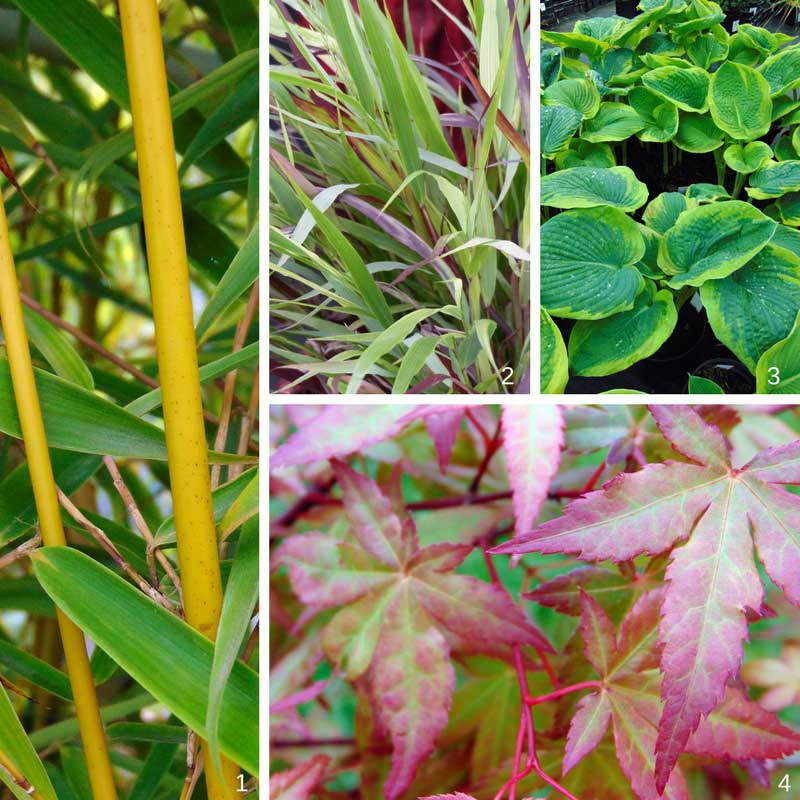
1) Fargesia robusta Campbell – 2) Hakonechloa macra Beni Kase – 3) Hosta sieboldiana Frances Williams – 4) Acer palmatum Redwine
Useful resources
- Discover our wide range of bamboos, selected for their ornamental qualities as well as the non-invasive nature of certain species!
- Founded in 1856, La Bambouseraie d’Anduze in the Cévennes hosts numerous varieties of dwarf and giant bamboos
- Discover 6 bamboos suitable for container growing
- Explore our selection of bamboos with decorative foliage!
- Our care guide: How to properly water a potted bamboo?
- Discover our selection of 6 fast-growing bamboos
- Read our series on travelling plants: bamboo
- Our plant profile: Bambusa – planting and cultivation
- Find our advice on: How to create a bamboo hedge?
- Subscribe!
- Contents


































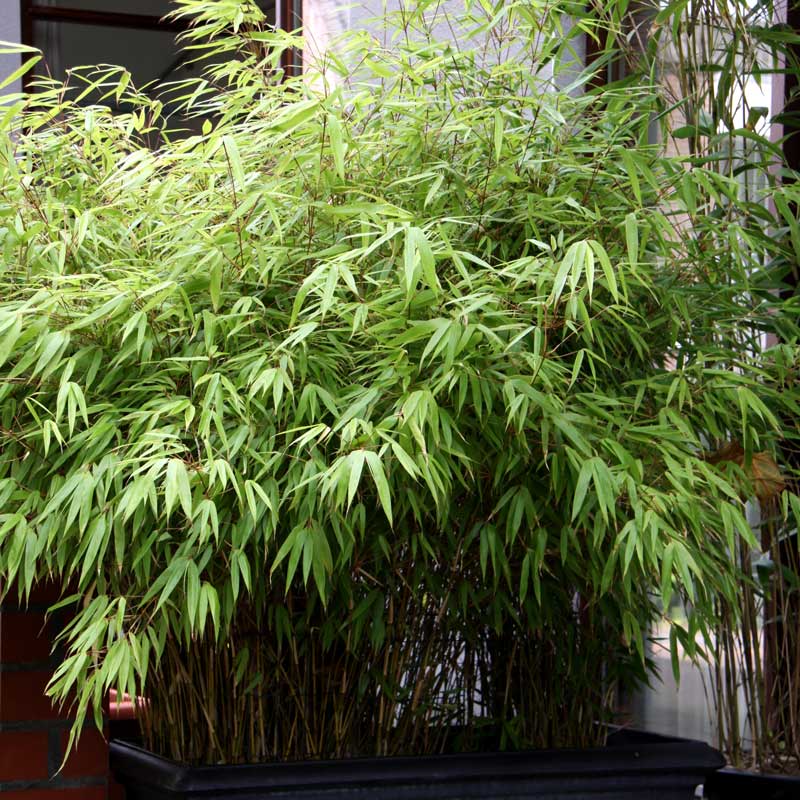
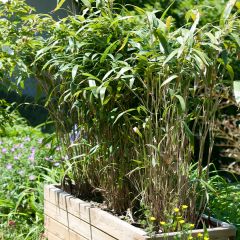
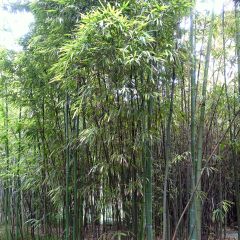

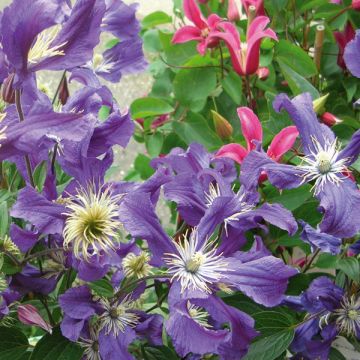
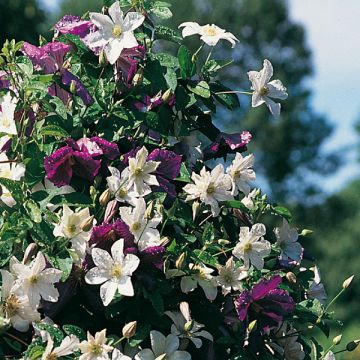
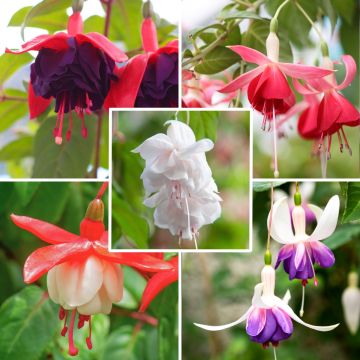
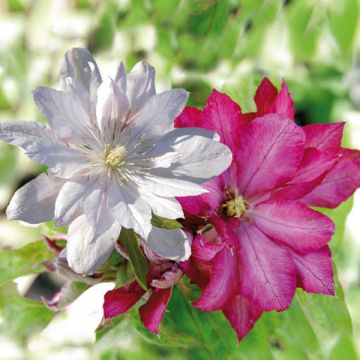
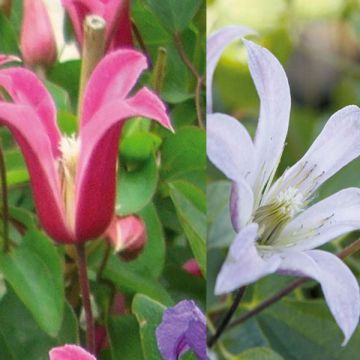
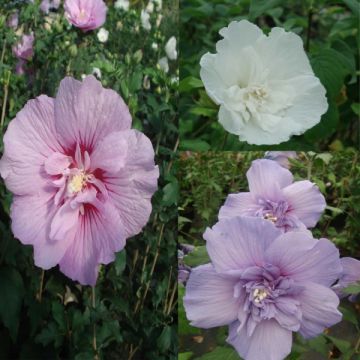
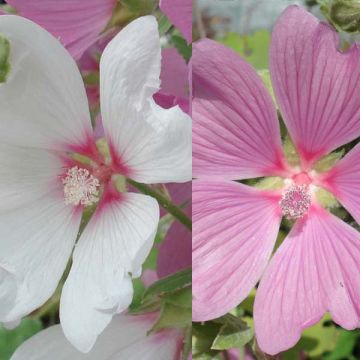
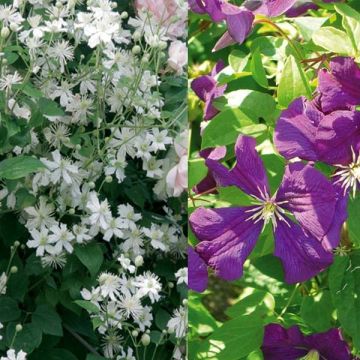

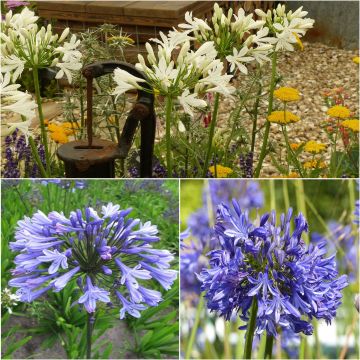
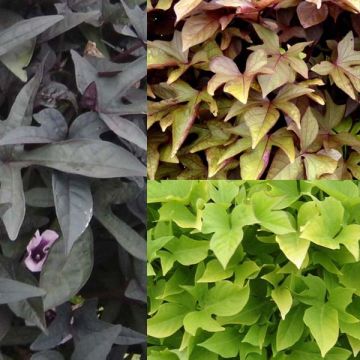
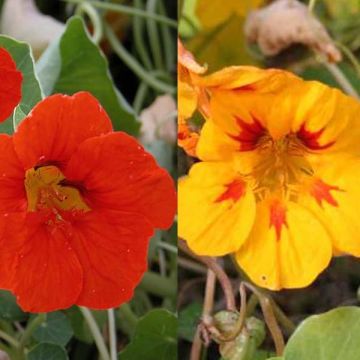
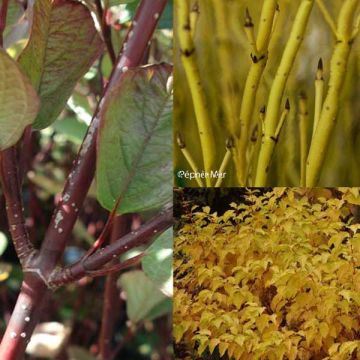
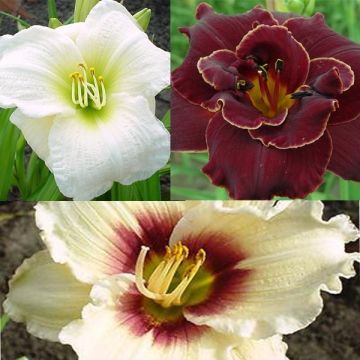
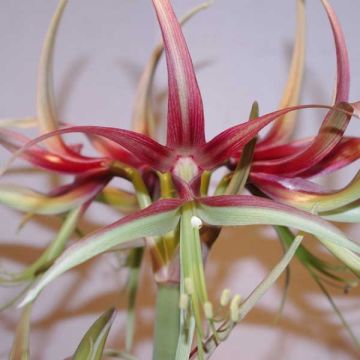

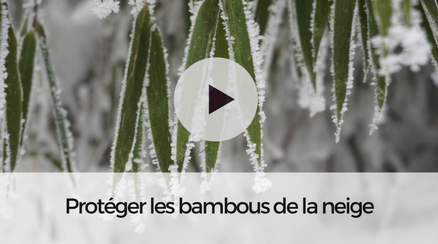
Comments